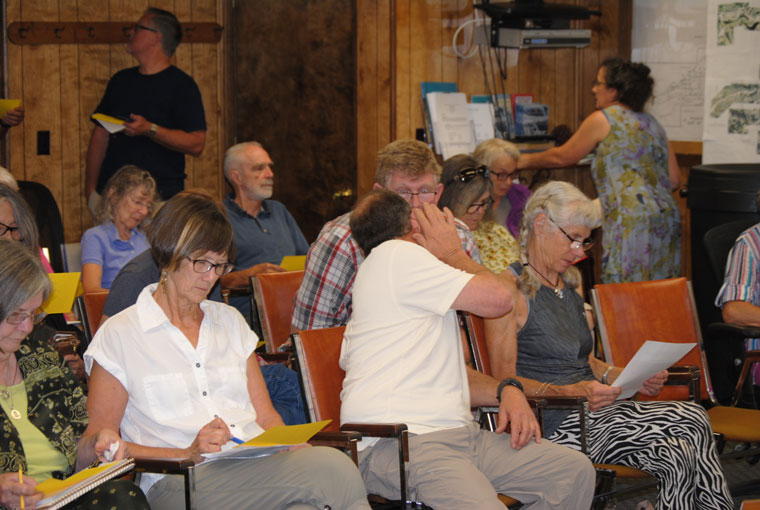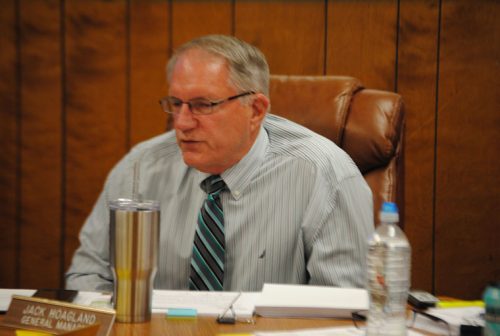Public upset IWD withheld water quality problem

Photos by JP Crumrine
Although there were only three items on the agenda for last week’s Idyllwild Water District meeting, the third, which was only informational, took nearly two hours to cover.
On July 9, General Manager Jack Hoagland announced that the test results for byproducts from disinfecting the water with chlorine were exceeding the state and federal limits. A notice to customers was mailed July 13. Most customers received the notice Monday or Tuesday, July 16 or 17.
As a result, the district’s board room was filled with people concerned about the situation, seeking more information and worried about health consequences. Many were attending their first water meeting, which normally has fewer than five public attendees.

For the public’s convenience, Vice President Peter Szabadi, in President Dr. Charles “Chip” Schelly’s absence, moved the water-quality issue to the first item on the agenda.
Hoagland explained the problem and emphasized that neither the state nor federal Environmental Quality Administration have designated the presence of these disinfectant byproducts in drinking water as a health emergency or crisis.
It is not uncommon for the chlorine, which removes the iron and manganese, which are a health hazard, to interact with excessive organic material in water to produce trihalomethane and haloacetic acid. These are the byproducts that over a very long time may create health problems for some individuals. In fact, Fern Valley Water District incurred a similar problem in 2004 and installed a special treatment facility which eliminated it within months.
For years, the results for TTHM and HAA in the IWD water were within acceptable limits. Consequently, the district only needed to sample its water for these chemicals once a year.
However, in September 2017, IWD learned that the HAA results for a sample from the end of Lower Pine Crest Avenue exceeded the contaminant level. The State Water Resources Control Board’s Division of Drinking Water became involved and ordered more frequent testing.
Since then, IWD has performed four more tests and three resulted in confirmation of the HAA levels, and then the TTHM results began exceeding contaminant levels. After the June 2018 results were reported, SWRCB issued a citation to IWD.
One of the citation’s requirements was notifying the customers of the situation. Besides the mail notification, the issue was on the agenda of the July 20 meeting.
Hoagland told the public that IWD has a consulting firm evaluating the problem and expects recommendations for the August meeting. This will allow time to evaluate the options before the district submits a plan to the state by Sept. 10. Because this is not a unique problem, Hoagland is confident that several solutions may be offered, but he is not sure which will be the most efficacious and efficient.
“Whatever option, it will probably cost a lot of money, so I’d like to be right the first time,” he said.
Obtaining state approval of a solution, acquiring the equipment, installing and testing it will take time, which is why Hoagland estimated the fix may take six to 12 months. But IWD is “working closely with the [Drinking Water Division] on a number of items,” he said.
Many people spoke to the board, and some were very concerned and worried about the potential health effects. For example, despite water officials emphasizing these byproducts were only long-term risks, Sue Nash, an IWD customer, who has cancer and other health problems, said her doctor told her not to drink the water.
Dave Pelham, whose cancer was being controlled for years, said it became more aggressive again this winter. While he repeated that he did not blame the district’s water, he lamented that he was not informed about the water quality issue.
“I honestly say I don’t think the TTHMs are the cause, but I don’t know and you don’t know,” he told the board. Nevertheless, he was prevented from making his own decisions, such as whether to filter his drinking and bathing water.
“It would be good to have this information for those with health challenges. I’m very sorry we didn’t have it. We want information as soon as it’s available,” he added.
Others expressed concern over the amount of time estimated to resolve the issue and how word of Idyllwild’s water quality problem might affect businesses such as camps for children or real estate.
“There’s a problem here that needs to be fixed,” commented Director Steve Kunkle. “We are going to fix it, but I’m worried about the time frame.”
Several speakers criticized the board’s delay informing the public. This erupted further when several directors said it was only shared because the state required it to be announced.
“IWD did not have to wait until the state forced them to tell us,” said Vic Sirkin. “I don’t know anyone who wouldn’t want to make their own choice. I personally will not drink this water.”
Many of the public felt that the district violated its claim of “transparency” on this issue.
Szabadi shared his concern and suggested that the board hold a special meeting within two or three weeks to share information about progress and resolution of the water quality.
“We should report regularly to the public regarding the readings, not just quarterly,” he added. This should continue until it is corrected, he urged his colleagues.


